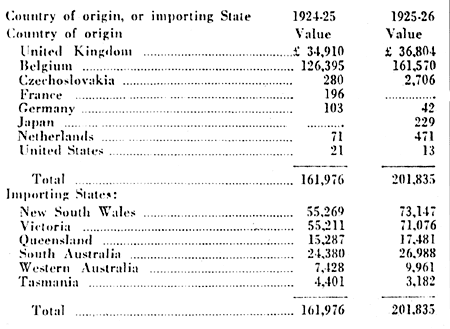[Trade Journal]
Publication: American Glass Review
Pittsburgh, PA, United States
vol. 47, no. 5, p. 17, col. 1-2
Glass Industry In Australia Progresses
THE glass industry in Australia is developing to such an extent that foreign importations are most likely to be greatly curtailed in the near future, in the opinion of United States Trade Commissioner Elmer G. Pauly, stationed at Melbourne. Prevalent conditions in the several branches of the industry in the dominion are reviewed as follows by Mr. Pauly in a late report to the Department of Commerce:
Substantial progress has already been made in the container branch, and in view of the recent agitation for a compulsory milk bottling law, the bottle making factories appear to be in good position to increase their business. Manufacture of sheet glass by one of the large organizations is also contemplated.
The Australian Glass Manufacturers' Co. (Ltd.), which controls most of the Australian bottle making trade, has five factories operating in the various states of Australia and one in New Zealand. Besides supplying brewers, the company is making strenuous efforts to encourage food packers to use glass containers, and since a patent vacuum seal has been secured, the demand for sealed bottles from food packers has increased rapidly.
The output of milk bottles has also shown an appreciable gain during the year. In anticipation of Victorian State legislation, requiring all milk to be delivered in sealed glass bottles, the company has a plant in reserve to meet promptly any sudden increase in demand. (Compulsory bottling of milk for retail delivery is one of the early measures to be considered by the new Victorian labor government.)
IMPROVEMENTS TO PLANT
The Australian Glass Manufacturers' Co. (Ltd.) has recently spent a large sum of money in modernizing its plant, the latest practices in glass manufacture having resulted in greater output, cheaper production and improved earnings.
During the latter part of 1926 the company acquired the sole Australian rights for the new annealing lehr's, which thermostatically control the annealing of bottles and jars, and these lehrs are now being installed throughout the plants. Where installation has been completed, it has been found that the new process has added considerably to the quality of the glass produced. This company recently acquired the ownership of a mechanical device designed to work in conjunction with the patent lehr, which will make production in the factories completely automatic.
The sole Australian rights for an improved glass feeder and bottle forming machine have also been acquired. This feeder is said to enable a more uniform quality to be maintained. The first model of the bottle forming machine, which is about to be shipped from the United States, is designed to produce (within certain limits) 75 per cent. more ware, according to statements made by the company's directors.
The company became established at Perth, Western Australia, during the latter part of 1926. The acquired works have been remodeled, and the factory is now turning out glass bottles in large quantities. Whereas a few years ago, brewers in Perth were making their own bottles, the Australian Glass Manufacturers' Co. (Ltd.) is now supplying most of their requirements.
Australian Glass Manufacturers' Co. (Ltd.) has an extensive engineering branch in each factory. The new lehrs are being turned out on the premises, as well as portions of the bottle milking and other machinery. A fair percentage of the machinery used, however, is still being imported.
A new bottle making unit, under construction at Spotswood, Victoria, which will be larger than the other plants, and will feature all the latest improvements in furnace construction, is expected to be in operation by October.
In the annual report and balance sheet of Australian Glass Manufacturers' Co. (Ltd.) for the year ended March 31, 1927, a profit of £179,358 is disclosed, as compared with £163,799 for 1925-26, and £151,210 for 1924-25. The report states that although the demand for glass bottles has been very satisfactory, the pressed and blown glassware section of the business has suffered severely from foreign competition. For this reason an application was made to the tariff board at the recent tariff hearings for increased protection but the result of these hearings has not yet been made public.
SHEET GLASS FROM BELGIUM
The bulk of the sheet glass imported into Australia comes from Belgium, with the United Kingdom, Czechoslovakia, and the Netherlands as next sources of supply.
The imports into Australia for 1925-26, compared with 1924-25, including countries of origin, and importing Australian States, are shown in the following table:
 |
